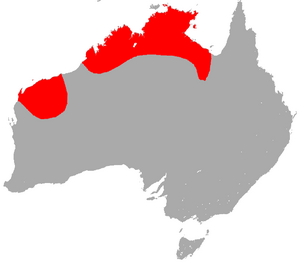Common sheath-tailed bat facts for kids
Quick facts for kids Common sheath-tailed bat |
|
|---|---|
| Conservation status | |
| Scientific classification | |
| Genus: |
Taphozous
|
| Species: |
georgianus
|
 |
|
| Common sheath-tailed bat range | |
The common sheath-tailed bat (Taphozous georgianus) is a type of bat found in northern Australia. It belongs to the family Emballonuridae, which are often called "sac-winged bats" because some of them have small pouches on their wings.
Contents
Discovering the Common Sheath-tailed Bat
This bat species was first described in 1915 by a scientist named Oldfield Thomas. He initially thought it was a new subspecies of another bat, calling it Taphozous australis georgianus. Later, in 1925, another scientist, Ellis Le Geyt Troughton, suggested it should be its own species. This idea was officially accepted in 1967.
The original bat specimen used to describe the species (called the holotype) is kept at the British Museum of Natural History. It's the skull and skin of a female bat. It was collected near King George Sound, but interestingly, this bat species hasn't been seen there since.
People also call this bat the common sheath-tailed bat or the sharp-nosed tomb bat.
What Does This Bat Look Like?
The common sheath-tailed bat has fur that is usually brown or grayish-brown. Its back is darker, and its belly is a bit lighter. The hair itself is creamy at the base.
- Snout: Their snout (nose area) is narrow and pointy.
- Head and Lips: Their lips and the bald part of their head are a dark brown color.
- Arms: They have fine, ginger-grey hairs under their arms.
- Size: Their forearm (the main bone in their wing) measures about 66 to 74 millimeters (about 2.6 to 2.9 inches). They weigh between 19 and 41 grams (about 0.7 to 1.4 ounces). The bat itself is no longer than 9 centimeters (about 3.5 inches).
- Ears: The outer half of their ear's tragus (a small flap in the ear) is folded inwards.
- Pouch: They have a small pouch near their wrist, but they don't have a throat pouch (called a gular sac).
- Tail: Most of their tail is covered by a membrane (skin flap) between their legs, but the very tip of the tail sticks out.
When these bats rest, they have a unique way of doing it. They lie very close to the surface they are on, stretching out their forearms. This makes their shoulders raise their head up, almost like a crab!
This bat looks similar to other sheath-tailed bats. It's smaller than Taphozous troughtoni, which also lives in northern Queensland. You can tell it apart from Taphozous hilli (found in central Australia) because the male common sheath-tailed bat doesn't have a neck pouch, and the space between its canine teeth is different.
How Do Common Sheath-tailed Bats Behave?
The common sheath-tailed bat spends most of its active time hunting for food. Its favorite meal is beetles, but it also eats other types of insects. Like most bats, they hunt at night.
- Hunting Style: When they fly, they follow straight paths, criss-crossing an area like a grid to find insects.
- Where They Hunt: They often hunt over water bodies like pools and creeks, and in bushland, where they can catch insects while flying.
- Habitat: These bats live in dry and tropical parts of northern Australia, usually near grassland or woodland. They can find food in many different types of places. They fly at a medium height compared to other bats.
During the day, these bats rest by pressing their bodies flat against the walls or ceilings of their underground homes. They prefer dark places.
- Colonies: They usually live in small groups, and the bats often hang more than half a meter apart. Sometimes, they might even roost alone or in pairs. However, groups of up to seventeen bats have been found in one cave. At some old mining sites, about fifty bats were seen in each location.
- Roosting Spots: They like to rest in cracks in vertical rock faces or on the roof of horizontal mines and caves.
- Resting During Foraging: If they need a break from hunting, they might rest on a rock face, staying close to a crack where they can hide if disturbed.
Where Do They Live and What Are Their Challenges?
The common sheath-tailed bat is very common in the tropical and subtropical areas of northern and western Australia.
- Homes: They mostly live in caves, old mines, and cracks in rocks. They also sometimes move into empty buildings, which might have helped them spread to new areas.
- Seasonal Movement: A group of bats might move to different local sites during the year, leaving some homes empty for a while.
Even though these bats fly high when they travel, they need to find water, which can bring them closer to dangers on the ground.
- Dangers: One big danger for these bats is barbed wire. They can get snagged and tangled in it, especially their delicate wing membranes. Many bats get hurt or die each year because of this common fencing material.
- Other Threats: Other things that can harm them include mining activities that destroy their roosting places, people disturbing them, and changes in how the land is managed.
- Conservation Status: Luckily, in Queensland and the Northern Territory, this species is listed as 'least concern', meaning it's not currently at high risk of disappearing.
It's important to know that if any bat in this region, including the common sheath-tailed bat, bites or scratches a person, there's a very small risk of getting a serious illness called Australian bat lyssavirus (ABLV). This disease is rare but can be very dangerous. It's always best to avoid touching bats. Otherwise, these bats are considered harmless.
See also
 In Spanish: Taphozous georgianus para niños
In Spanish: Taphozous georgianus para niños


